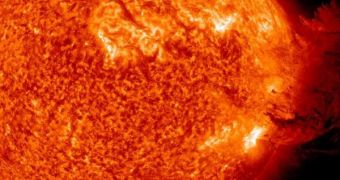A massive solar flare produced this week made auroras more intense in the Northern Hemisphere last night (June 8), and will most likely do the same tonight. Amateur skywatchers can track the phenomena taking place at high latitudes.
Experts say that the light displays may be remarkably strong, as streams of highly-charged particles collider with our planet's magnetosphere, and slid down on magnetic lines. This is what gives auroras their specific appearance.
Monitoring spacecraft indicate that the massive solar flare that sparked these events was produced on the surface of the Sun early Tuesday, on June 7. Though millions of tons of matter were hurled towards our planet, astronomers say that the event only had a medium intensity.
The NASA Solar Dynamics Observatory (SDO) kept a close eye on the event, gaging the risks it could pose on our planet, and then sending the data back to its human mission controllers. The spacecraft, and others like it, are our first line of defense against such events.
When material ejected by solar flares is directed towards our planet, the massive inflow of charged particles can breach through the magnetosphere's protective shielding, and reach the planetary surface.
This can fry transformers and other electric grid components, causing widespread blackouts and other mischief. The radiation can also fry the electronics aboard orbital satellites, though many spacecraft now have shielding against these particle flows.
Astronauts aboard the International Space Station (ISS) are also endangered by such solar events, so space agencies involved in the project are very cautious in keeping the 6-astronaut crew safe.
The new solar flare was a coronal mass ejection (CME). Such events usually originate among active sunspots, and are associated with other types of solar events. However, thus far, solar physicists have been unable to establish a causal connection between CME and solar flares, for example.
“The CME should deliver a glancing blow to Earth's magnetic field during the late hours of June 8th or June 9th. High-latitude skywatchers should be alert for auroras when the CME arrives,” a statement from the American space agency reads.
“The eruption took place well off-center, which means that the lion's share of the electrified particles shot into space will probably miss Earth,” says Joe Rao, who is a skywatching columnist for Space.
“But nonetheless, this M-2 flare still appears potent enough, to send enough subatomic material our way to interact to some degree with our magnetic poles, though I think the main show will be for places at high latitudes,” he concludes.

 14 DAY TRIAL //
14 DAY TRIAL //